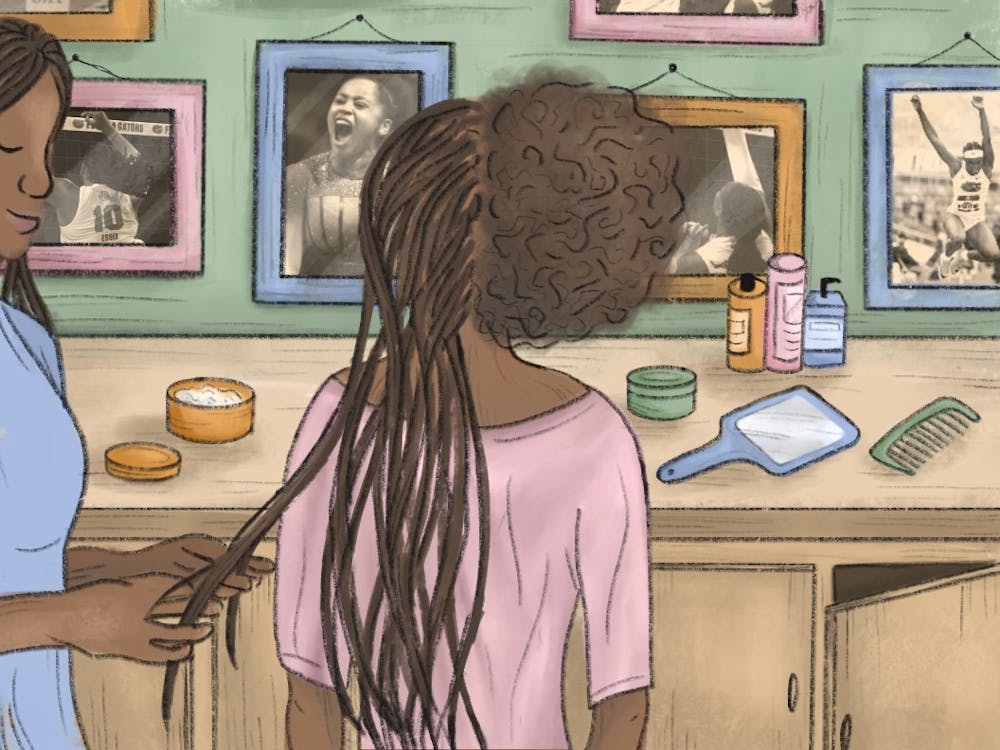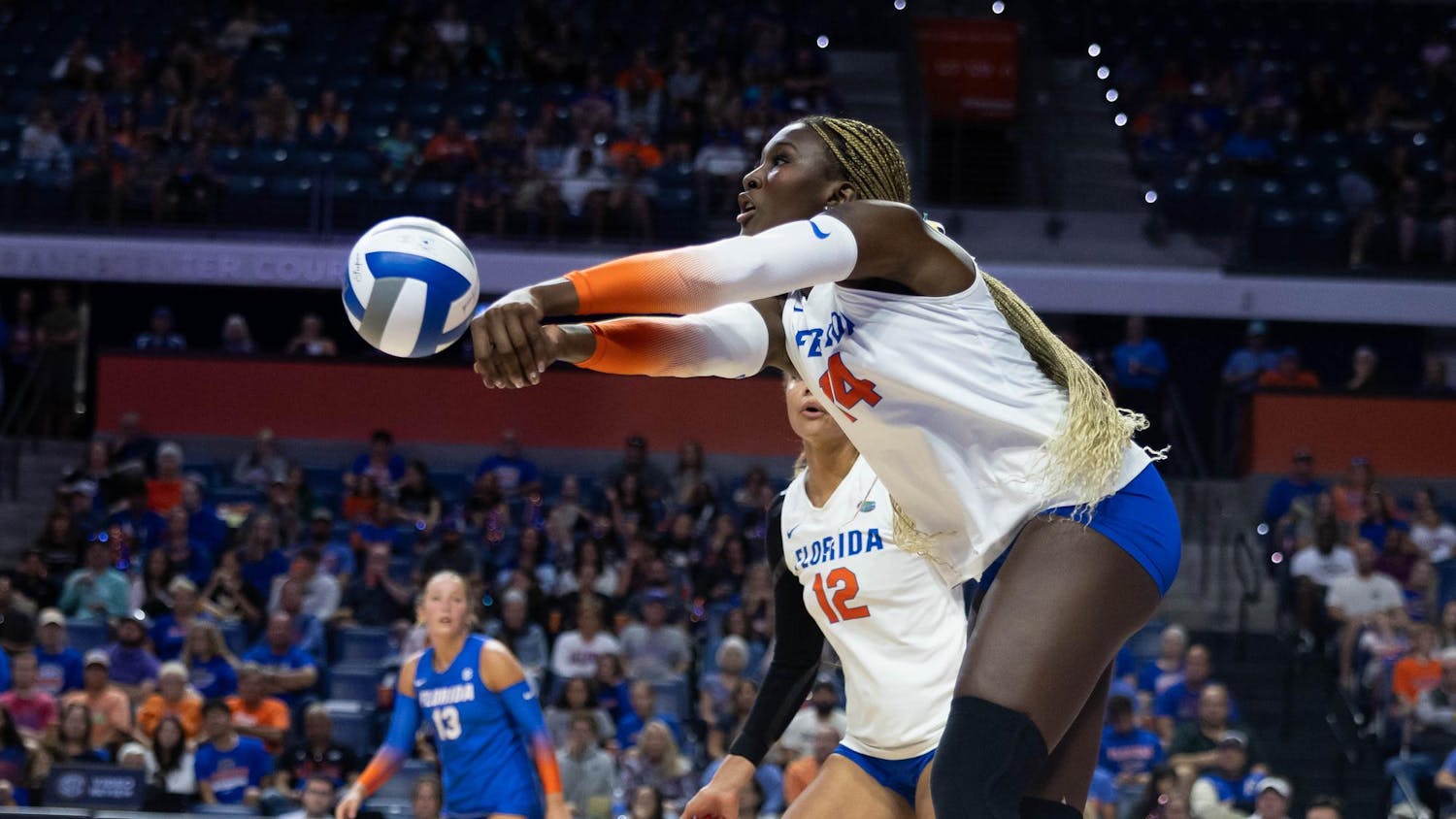Sloane Blakely was 5 years old when she started club gymnastics. For years, she was forced to pull her hair up into a sock bun — a tight bun that was very difficult for Blakely to wrap her coily, coarse hair around.
One day, she decided to wear her hair naturally instead.
“It was a very big deal when I started wearing my hair like this in club,” Blakely said. “My club coach — she didn't like that. She was not used to it, but that’s how I would always wear my hair for practice, so why not do it for the meet?”
Black women in sports frequently face scrutiny for their hair. Many of them have to jump through hoops in order to maintain practical hairstyles while keeping their identity.
Professional athletes, such as gymnast Gabby Douglas and track runner Sha’Carri Richardson, have received backlash in recent years for the way they style their hair.
Blakely, now a sophomore at UF, competes on the Gators’ gymnastics team. She hasn’t faced any criticism for her hairstyles since she’s been at Florida, but she recalled her experience with her club team in Texas.
“It’s always been ‘It’s too big’,’” Blakely said. “I always second-guessed — should it be big? But that’s just how my hair is.”
There are four girls on the team who share similar hair textures, UF junior gymnast Alex Magee said. They often discuss how they’re going to do their hair for competition with each other.
The others wear their hair out more often than Magee, who usually keeps her hair in a protective style in an effort to help it grow.
“I’m trying to grow my hair to my waist, so I don’t touch my hair,” Magee said. “That’s why I keep it in braids or twists with added hair.”
Magee does her homework days in advance in preparation for braiding her hair.
Sometimes, she’s able to begin braiding her hair in the morning and finish later that same evening, but it can take multiple days for her to complete her hairstyle. If she doesn’t have her hair in braids, instead wearing it out in more of a puff style, Magee sets aside three hours to do her hair for the meet either the day of or the day before.
The girls with straighter, less coarse hair usually do their hair the day of, Magee said. UF graduate student Trinity Thomas and sophomore Bri Edwards will occasionally help do other gymnasts' hair, only needing about 15 minutes for each girl.
Magee recalls the speculations she would receive in her hometown for the way she would do her hair, especially with hairstyles which included added hair.
“If I want to change my hair, I'm going to change it,” Magee said. “Because nobody else is paying for this, and nobody else is doing my hair. It's me.”
Magee understands people with different hair textures might not understand why she does her hair the way she does. But she also believes there are ways for people to educate themselves and ask questions without being disrespectful.
Her previous coaches — who were uneducated on the history of Black women or their hair — sometimes made comments because they didn’t understand, Magee said.
“They probably weren't around a lot of Black girls growing up or girls who did the things that I did to my hair,” Magee said.
Florida sophomore volleyball player Gabrielle Essix also competes with box braids because she finds it easier to style than her natural hair.
“I do wish that I had the choice to experiment with my hair because natural hair is becoming more of a thing,” Essix said. “My natural hair is a little dry sometimes, and it's hard to manage.”
Essix permed and flat-ironed her hair every day as a child to fit in with her predominantly white neighborhood.
“Especially in volleyball,” Essix said. “I really was like ‘Oh, my teammates are over here. So let me be with my teammates,’ instead of branching out and finding my own identity in the Black community.”
Essix admires South Carolina basketball player Aliyah Boston for the vibrant colors she adds to her braids. However, she doesn’t think she could do a hairstyle like that in her sport, she said.
Because there aren’t as many Black girls in volleyball, Essix feels as though the standards are different than the ones held in basketball.
“Some of the styles that you would see and some of the actions or the way people act are perceived differently on both sides,” Essix said.
She fears her choices would be seen as aggressive, falling into the “angry Black woman” stereotype, if she tried to stand up for herself.
As a result, Essix usually sticks with a single hairstyle — one ponytail with a smaller one on top. The ends of her braids are curled, and she thinks that’s why many people want to touch them.
“They'll just come up behind me and randomly pull my hair,” Essix said. “I feel like they don't realize that the hair is very much attached to my head.”
Florida junior Alissa Braxton — a jumper on Florida’s track and field team — admits there are advantages to participating in predominantly Black sports.
“When we go to compete, there's tons of girls with different hairstyles, different colors,” Braxton said. “I feel like we definitely have versatility and diversity.”
Braxton competed with many different hairstyles in the past. This semester, she will be competing with locs — a hairstyle where the hair is coiled and twisted into a more rope-like appearance. She usually did her hair before the team traveled so she would only have to neaten it up before the meet.
Now, with the locs, styling is quick and simple.
Braxton promotes the adaptability of Black hair. She believes it evolves over time and people should be able to style their hair as they want to at the moment.
There are coaches who see makeup, hair and nails as a distraction, Braxton said. She believes this is just part of some athletes’ routines, and it’s how they become more confident for competition.
“We just like to look good, and why not look good doing the things that we love to do,” Braxton said.
Contact Namari Lock at nlock@alligator.org. Follow him on Twitter @Namari_L.
Namari Lock is a third-year journalism student and production staff member for The Alligator. She has previously worked as multimedia editor, opinions editor, graphic designer and as a general assignment reporter for the Metro desk. In her last semester at UF, Namari is making her Alligator Sports debut as track and field reporter.






